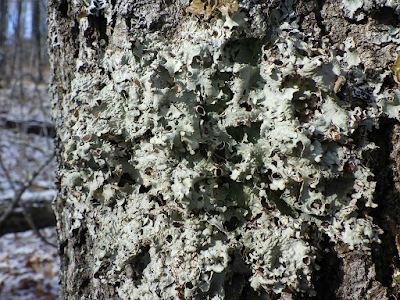Metallophytes
Last fall John took Connor and I to some locations to explore metallophytic lichens. These are lichens which are restricted to growing in meta-rich environments. In the case of Minnesota they are restricted to the iron-rich rocks of the Gunflint formation. These lichens are obligates, that is this is the only type of environment they grow in. Another term to describe this is edaphic endemism. Endemism usually refers to species only found in one specific geographic location, whereas edaphic refers to soil, so organisms found only on one specific type of substrate. High concentrations of metals in rock or soil are usually toxic to most organisms, so to grow here these lichens have unique adaptations to deal with these conditions. These adaptations make them extremely fit in these environmental conditions, where little else can survive. However, in less extreme environments they are easily outcompeted by more vigorous species. This is a trend seen in edaphic endemic plants of serpentine and other ultramafic rocks which also weather to produce toxic soils. Just like with other edaphic endemics these lichens are regionally (and often globally) rare to uncommon, making them significant additions to the flora of the area.
Notice the bright orange, red, or yellow color. The metallophytes often are these bright colors that blend in with the surrounding rock. Likely a combination of metal accumulation within the tissue and staining by the oxidizing iron. While two species might not seem too impressive they are so colorful and distinctive that it was quite the treat. That in addition to their fascinating natural history. There were a variety of other species that I couldn’t ID based on gross morphology alone. Who could say what exactly they were. There are a second type of metallophytes, species that are facultative. That is they can grow in these metal-rich habitats, but they are also found elsewhere. Maybe some of these unknowns are obligates and maybe some are facultative.
I had some free time so I headed up the Gunflint trail to see what else I could find. The first spot was truly magical, filled with many amazing views and fascinating plants and lichens. Many of these species were new to me. The cliffs I explored looked mostly similar to other ones, but every now and then a small portion of it would have these metal-rich rocks exposed.
The first north-facing slope of the day
The second north-facing cliff
First I explored the talus on the way up. There were lots of cool species, but here are a few highlights:
Finger ring lichen (Arctoparmelia incurva), with this sighting I’ve now seen all 3 species in the genera known from MN
State Watchlist Species
A beautiful rosette of finger ring lichen, the center commonly dies back, giving the genus its common name
State Special Concern Species
Blistered rock tripe (Umbilicaria hyperborea)
State Watchlist Species
State Special Concern Species
Arthrorhaphis sp.
State Special Concern Species
But the best part was on the cliff. At first it was a lot of your “typical” rare species you’d expect in this type of habitat. Right next to the metal rich rocks there were some species that I’d never seen, or rarely seen, and finally came the metallophytes. This pattern repeated for both the first and second cliff.
Dwarf bilberry (Vaccinium cespitosum)
Squash berry (Viburnum edule)
Encrusted saxifrage (Saxifraga paniculata)
State Special Concern Species
Rock whitlow mustard (Draba aribasans)
State Special Concern Species
Hanging Fringe Lichen (Anaptychia crinalis)
State Special Concern Species
Punctelia stictica
State Endangered Species
Shag-belly stippleback lichen (Dermatocarpon moulinsii)
State Endangered Species
State Watchlist Species
Quilted stippleback lichen (Dermatocarpon intestiniforme)
State Watchlist Species
Rock jewel lichen (Calogaya saxicola)
Leproplaca cirrochroa
The metallophytes:
Oeder’s map lichen (Rhizocarpon oederi)
Lecanora epanora
State Threatened Species
I camped overnight and headed to the second location. A lot of similar species were there. This site had much more metallic rock, and many more metallophytic lichens. Two highlights were Lecanora gisleriana and Lecanora handelii, both species were recent continental records for North America, first reported by Samuel Brinker in Ontario.
Lecanora epanora is the yellow lichen, the apothecia belong to the lichenicolous species Lecanora gisleriana
Lecanora handelii, although not in this photo this species was also commonly parasitized by L. gisleriana
Again, there were a bunch of unknown species:
Overlooking the lake at one of the few portions of exposed metal-rich rock
I’m not sure exactly what type of rock it is, but the fracture pattern and color were drastically different than the surrounding bedrock












































Comments
Post a Comment